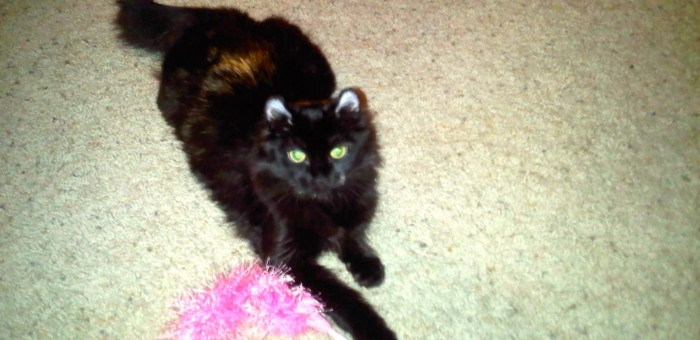When I was first contacted by Annie, she was quite distraught. She told me her vet suggested she contact me because the vet couldn’t figure out what was wrong with Annie’s cat Lola. Annie told me that Lola – a lovely long haired black cat – had been attacking her own tail. The vet told Annie that Lola had an emotional problem and wanted to put Lola on Prozac. Annie was not convinced that Lola had emotional issues and asked me to talk to Lola.
When I asked Lola to tell me about her tail, I was really shocked. What she showed me was that she would be sitting quietly and suddenly would viscously attack a particular spot on her tail – biting it with her teeth. Then after a few seconds, would leave the spot alone and would act normal again. Annie reported that this was exactly what happened – over and over through out the day, to the point that a serious wound had developed at the spot.
However, I did not feel that this was an O.C.D.-type behavior or an emotional issue – my feeling was that there was a physical cause. I asked Lola how her tail felt when she would attack that particular spot – she showed me that it felt like an almost electric shock – the feeling of a suddenly pinched nerve. In an attempt to make it stop, Lola would attack and bite her tail at the spot where she felt the nerve pain.
Because I am a medical intuitive, I can “look” inside an animal’s body to see how they are feeling. This can be really helpful – as it was in Lola’s case. When I “looked” at Lola’s tail, what I saw was a misalignment of two vertebrae in her tail – and one of the two vertebra also had a crack in it. This made sense to me, based on what Lola showed me about the nerve pain. I suggested that Annie have the vet take an x-ray of Lola’s tail. Annie said she would follow up with the vet.
Soon there after, Lola had her x-ray. The results showed exactly what I had seen – two misaligned vertebrae and a crack in one of them. Unfortunately, the wound over the site of the vertebrae had become dangerously infected and part of Lola’s tail had to be amputated immediately to prevent the infection from spreading further.
We talked to Lola again after the amputation and we assured her that she was still very beautiful and would now be pain free. While Lola wasn’t happy about loosing part of her tail, she was VERY happy about not having the nerve pain any more. Annie reported that Lola had not attacked her tail once since the surgery either!
Not long after Lola’s surgery, Annie was preparing to move to Florida. We talked to Lola and Annie’s other cat, about the upcoming move. The move went smoothly and they all got settled in Florida.
I didn’t hear from Annie for several months, but when I did hear from her, she was really concerned – Lola had started attacking the stub end of her tail. When I asked Lola why she was attacking her tail again, she showed me clearly that the problem was nerve related . . . she was having classic phantom limb syndrome pain – but of course in her case, it was phantom tail pain!
I suggested that Annie contact her local vet to get some pain medication for Lola. I felt that if she could get pain relief and gradually decrease the dose of the pain medication, that the nerve irritation would subside and Lola would be able to leave her tail alone.
Annie was able to get the pain medication from the vet and after a month or so of gradually decreasing the dosage, Lola was again pain free and was leaving her tail alone!
Several years have passed and Lola remains pain free – and her tail, although a bit shorter than it once was, it is still beautiful and – best of all – has been safe from attack!
“Poor Lola would have been on Prozac for no reason at all, but Sky found out what was really wrong with Lola’s tail and we were able to resolve it. I was blown away by the accuracy of Sky’s reading and am so grateful I listened to her suggestions. Thanks again, Sky, I can’t thank you enough!” – Annie E., FL

